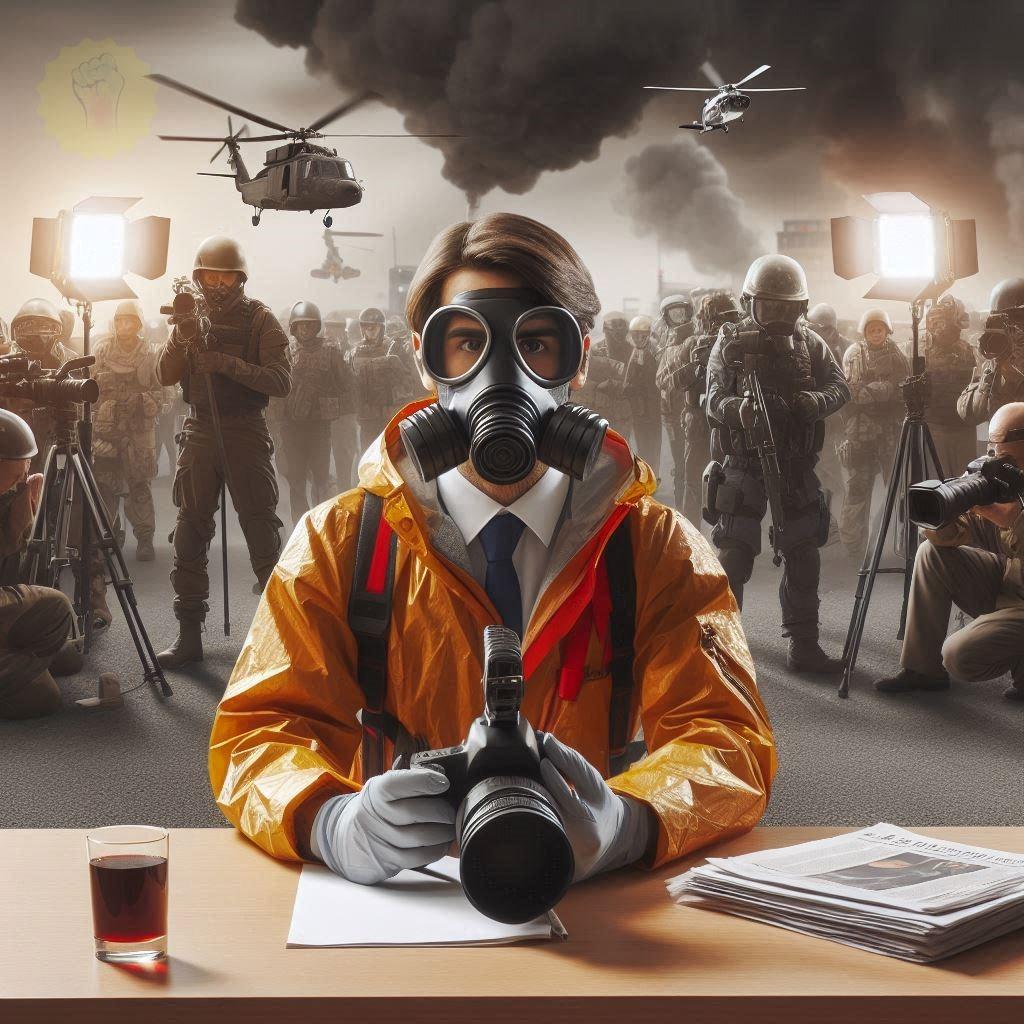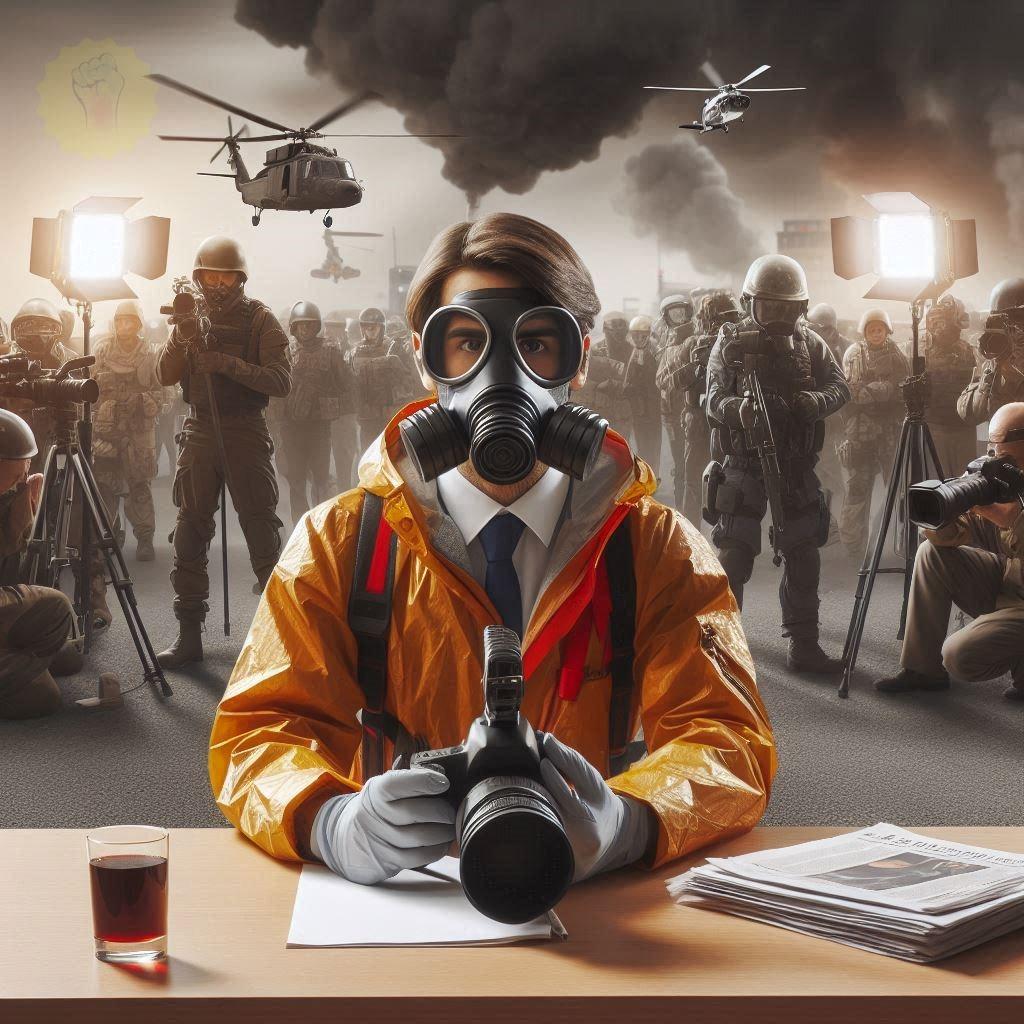సంక్షోభ పరిస్థితుల్లో రిపోర్టర్ల పాత్ర!
సంక్షోభ పరిస్థితుల్లో, సహజ వైపరిణామాలు, మహమ్మారులు మరియు ఇతర అత్యవసర పరిస్థితుల సమయంలో రిపోర్టర్లు ప్రజలకు అవసరమైన సమాచారాన్ని అందించడం చాలా ముఖ్యమైనది. వారి పని ప్రజలకు ఖచ్చితమైన మరియు సమయానికి సంబంధించిన సమాచారం అందించడంలో సహాయపడుతుంది, ఇది ప్రాణాలను కాపాడటానికి మరియు భద్రతను ప్రోత్సహించటానికి సహాయపడుతుంది. ఈ క్రింది విధంగా రిపోర్టర్లు ఈ కష్టం ఉన్న పరిస్థితులను ఎలా నావిగేట్ చేస్తారో మరియు కొన్ని ముఖ్యమైన కేస్ స్టడీస్ ద్వారా వారి ప్రభావాన్ని తెలుసుకుందాం.
సంక్షోభ పరిస్థితులను నిర్వహించడం
1. సమాచారాన్ని సేకరించడం: సంక్షోభ సమయంలో రిపోర్టర్ల ప్రాథమిక పని ఖచ్చితమైన సమాచారాన్ని సేకరించడం. ఇది అధికారులు, ప్రథమ స్పందకులు మరియు ప్రభావిత వ్యక్తులతో ఇంటర్వ్యూ చేయడం మరియు సామాజిక మాధ్యమం మరియు అధికారిక ప్రకటనలను పర్యవేక్షించడం చేర్చుతుంది. విశ్వసనీయ సమాచారం త్వరగా అందించడం చాలా అవసరం.
2. సత్యాన్వేషణ మరియు ఫ్యాక్ట్-చెకింగ్: సంక్షోభ సమయంలో, అబద్ధ సమాచారం వేగంగా పరక్రమిస్తుంది. రిపోర్టర్లు సమాచారాన్ని ప్రచురించే ముందు దాన్ని ధృవీకరించడానికి కఠినమైన ప్రక్రియలను ఉపయోగించాలి. ఇది అనేక మూలాల నుండి డేటాను క్రాస్-రెఫరెన్స్ చేయడం మరియు నిర్ధారించని క్లెయిమ్స్ పట్ల జాగ్రత్తగా ఉండటం చేర్చుతుంది.
3. ప్రజా భద్రతను ప్రాధమికంగా ఉంచడం: రిపోర్టర్లు వారి కవర్ చేయడంలో ప్రజల భద్రతను ప్రాధమికంగా ఉంచాలి. ఇది సహజ విపత్తుల సమయంలో ప్రజలకు నిర్ణయాలు తీసుకోవడానికి సహాయపడే సమాచారాన్ని అందించడం, లేదా మహమ్మారి సమయంలో సురక్షితమైన ఆచారాలను చేర్చడం వంటివి ఉంటుంది. స్పష్టమైన మరియు సంక్షిప్త సమాచారాన్ని అందించడం కీలకంగా ఉంటుంది.
4. భావోద్వేగ సున్నితత్వం: సంక్షోభ సమయంలో జర్నలిజం యొక్క సున్నితమైనతనాన్ని అర్థం చేసుకోవడం చాలా అవసరం. రిపోర్టర్లు బాధిత వ్యక్తులు మరియు సమూహాల భావోద్వేగాలను అర్థం చేసుకుని, వారి కథలను నైజంగా చేర్చాలి. ఈ సున్నితత్వం సమాజంతో విశ్వాసాన్ని కట్టడానికి మరియు కవర్ చేసే నాణ్యతను పెంచడానికి సహాయపడుతుంది.
5. మార్పుల ప్రకారం క్రమం: సంక్షోభాలు వేగంగా మారవచ్చు, మరియు రిపోర్టర్లు వారి కవర్ చేయడంలో సాఫీగా ఉండాలి. కొత్త సమాచారం వెలువడినప్పుడు, వారు తమ కవర్ను మారుస్తున్నారు, ఇది ప్రజలకు ప్రస్తుత అప్డేట్స్ అందించడానికి అవసరం.
ప్రాముఖ్యమైన కేస్ స్టడీస్
1. హరికేన్కాటరిన (2005): హరికేన్కాటరిన్ సమయంలో, చాలా రిపోర్టర్లు నష్టాన్ని కవర్ చేయడంలో కష్టాలు ఎదుర్కొన్నారు. అసోసియేటెడ్ ప్రెస్ మరియు CNN నుండి జర్నలిస్టులు నిరంతర కవర్ అందించారు, ఇది స్థానిక ప్రజల బాధను మరియు ప్రభుత్వ ప్రతిస్పందనలో ఉన్న లోటును చూపించాయి. వారి కథనాలు అవగాహన పెంచడంలో మరియు సంక్షోభ ప్రతిస్పందన గురించి జాతీయ చర్చను ప్రారంభించడంలో సహాయపడింది.
○ సాధించిన పాఠాలు: స్థానిక సమాజం కోసం రిపోర్టర్లు నిధానం గురించి నిరంతర అవగాహనను కలిగి ఉండటానికి అవసరం. కవర్ చేయడంలో సమాచారాన్ని సమర్థంగా కలుపుకోవడానికి మరియు సమాచారాన్ని అందించడానికి మంచి భద్రత కల్పించడం అవసరం.
2. COVID-19 మహమ్మారి: COVID-19 మహమ్మారి రిపోర్టర్లకు కొత్త సవాళ్లను ఇచ్చింది, ఎందుకంటే వారు ప్రజలకు సమయానికి వార్తలను అందించటానికి ప్రజా ఆరోగ్య సమస్యం మరియు సమాచారాన్ని సమర్థించడానికి అడ్డంకులు ఎదుర్కొనేవారు. The New York Times మరియు NPR వంటి రిపోర్టర్లు వైరస్ యొక్క ప్రసారం, భద్రతా మార్గదర్శకాలు మరియు టీకా అభివృద్ధుల గురించి అవసరమైన సమాచారాన్ని అందించారు.
○ సాధించిన పాఠాలు: స్పష్టమైన మరియు తేలికైన సమాచారాన్ని అందించడం అవసరం. అలాగే, అబద్ధ సమాచారాన్ని ఎదుర్కొనడంలో రిపోర్టర్ల పాత్ర ముఖ్యమైనది అవుతుంది.
3. కేలిఫోర్నియాలో కుండల ప్రవాహాలు (2020): కేలిఫోర్నియాలో జరిగిన కుండల ప్రవాహాలలో రిపోర్టర్లు రాత్రి పొడవుగా ప్రజలకు అనేక అప్డేట్స్ అందించడానికి పని చేశారు. ABC News మరియు స్థానిక స్టేషన్లు ప్రజలను సమాచారంతో సరఫరా చేసేందుకు సామాజిక మీడియాను ఉపయోగించారు.
సాధించిన పాఠాలు: త్వరగా మరియు విశ్వసనీయ సమాచారాన్ని అందించాలి. స్థానిక సంస్థలతో కలిసి పనిచేయడం ద్వారా ఆఫ్ఫెర్డ్ వాయిస్లను కవర్ చేయడం ద్వారా కొంత విలువను కలిగి ఉంటుంది.
#Bharat Aawaz
సంక్షోభ పరిస్థితుల్లో, సహజ వైపరిణామాలు, మహమ్మారులు మరియు ఇతర అత్యవసర పరిస్థితుల సమయంలో రిపోర్టర్లు ప్రజలకు అవసరమైన సమాచారాన్ని అందించడం చాలా ముఖ్యమైనది. వారి పని ప్రజలకు ఖచ్చితమైన మరియు సమయానికి సంబంధించిన సమాచారం అందించడంలో సహాయపడుతుంది, ఇది ప్రాణాలను కాపాడటానికి మరియు భద్రతను ప్రోత్సహించటానికి సహాయపడుతుంది. ఈ క్రింది విధంగా రిపోర్టర్లు ఈ కష్టం ఉన్న పరిస్థితులను ఎలా నావిగేట్ చేస్తారో మరియు కొన్ని ముఖ్యమైన కేస్ స్టడీస్ ద్వారా వారి ప్రభావాన్ని తెలుసుకుందాం.
సంక్షోభ పరిస్థితులను నిర్వహించడం
1. సమాచారాన్ని సేకరించడం: సంక్షోభ సమయంలో రిపోర్టర్ల ప్రాథమిక పని ఖచ్చితమైన సమాచారాన్ని సేకరించడం. ఇది అధికారులు, ప్రథమ స్పందకులు మరియు ప్రభావిత వ్యక్తులతో ఇంటర్వ్యూ చేయడం మరియు సామాజిక మాధ్యమం మరియు అధికారిక ప్రకటనలను పర్యవేక్షించడం చేర్చుతుంది. విశ్వసనీయ సమాచారం త్వరగా అందించడం చాలా అవసరం.
2. సత్యాన్వేషణ మరియు ఫ్యాక్ట్-చెకింగ్: సంక్షోభ సమయంలో, అబద్ధ సమాచారం వేగంగా పరక్రమిస్తుంది. రిపోర్టర్లు సమాచారాన్ని ప్రచురించే ముందు దాన్ని ధృవీకరించడానికి కఠినమైన ప్రక్రియలను ఉపయోగించాలి. ఇది అనేక మూలాల నుండి డేటాను క్రాస్-రెఫరెన్స్ చేయడం మరియు నిర్ధారించని క్లెయిమ్స్ పట్ల జాగ్రత్తగా ఉండటం చేర్చుతుంది.
3. ప్రజా భద్రతను ప్రాధమికంగా ఉంచడం: రిపోర్టర్లు వారి కవర్ చేయడంలో ప్రజల భద్రతను ప్రాధమికంగా ఉంచాలి. ఇది సహజ విపత్తుల సమయంలో ప్రజలకు నిర్ణయాలు తీసుకోవడానికి సహాయపడే సమాచారాన్ని అందించడం, లేదా మహమ్మారి సమయంలో సురక్షితమైన ఆచారాలను చేర్చడం వంటివి ఉంటుంది. స్పష్టమైన మరియు సంక్షిప్త సమాచారాన్ని అందించడం కీలకంగా ఉంటుంది.
4. భావోద్వేగ సున్నితత్వం: సంక్షోభ సమయంలో జర్నలిజం యొక్క సున్నితమైనతనాన్ని అర్థం చేసుకోవడం చాలా అవసరం. రిపోర్టర్లు బాధిత వ్యక్తులు మరియు సమూహాల భావోద్వేగాలను అర్థం చేసుకుని, వారి కథలను నైజంగా చేర్చాలి. ఈ సున్నితత్వం సమాజంతో విశ్వాసాన్ని కట్టడానికి మరియు కవర్ చేసే నాణ్యతను పెంచడానికి సహాయపడుతుంది.
5. మార్పుల ప్రకారం క్రమం: సంక్షోభాలు వేగంగా మారవచ్చు, మరియు రిపోర్టర్లు వారి కవర్ చేయడంలో సాఫీగా ఉండాలి. కొత్త సమాచారం వెలువడినప్పుడు, వారు తమ కవర్ను మారుస్తున్నారు, ఇది ప్రజలకు ప్రస్తుత అప్డేట్స్ అందించడానికి అవసరం.
ప్రాముఖ్యమైన కేస్ స్టడీస్
1. హరికేన్కాటరిన (2005): హరికేన్కాటరిన్ సమయంలో, చాలా రిపోర్టర్లు నష్టాన్ని కవర్ చేయడంలో కష్టాలు ఎదుర్కొన్నారు. అసోసియేటెడ్ ప్రెస్ మరియు CNN నుండి జర్నలిస్టులు నిరంతర కవర్ అందించారు, ఇది స్థానిక ప్రజల బాధను మరియు ప్రభుత్వ ప్రతిస్పందనలో ఉన్న లోటును చూపించాయి. వారి కథనాలు అవగాహన పెంచడంలో మరియు సంక్షోభ ప్రతిస్పందన గురించి జాతీయ చర్చను ప్రారంభించడంలో సహాయపడింది.
○ సాధించిన పాఠాలు: స్థానిక సమాజం కోసం రిపోర్టర్లు నిధానం గురించి నిరంతర అవగాహనను కలిగి ఉండటానికి అవసరం. కవర్ చేయడంలో సమాచారాన్ని సమర్థంగా కలుపుకోవడానికి మరియు సమాచారాన్ని అందించడానికి మంచి భద్రత కల్పించడం అవసరం.
2. COVID-19 మహమ్మారి: COVID-19 మహమ్మారి రిపోర్టర్లకు కొత్త సవాళ్లను ఇచ్చింది, ఎందుకంటే వారు ప్రజలకు సమయానికి వార్తలను అందించటానికి ప్రజా ఆరోగ్య సమస్యం మరియు సమాచారాన్ని సమర్థించడానికి అడ్డంకులు ఎదుర్కొనేవారు. The New York Times మరియు NPR వంటి రిపోర్టర్లు వైరస్ యొక్క ప్రసారం, భద్రతా మార్గదర్శకాలు మరియు టీకా అభివృద్ధుల గురించి అవసరమైన సమాచారాన్ని అందించారు.
○ సాధించిన పాఠాలు: స్పష్టమైన మరియు తేలికైన సమాచారాన్ని అందించడం అవసరం. అలాగే, అబద్ధ సమాచారాన్ని ఎదుర్కొనడంలో రిపోర్టర్ల పాత్ర ముఖ్యమైనది అవుతుంది.
3. కేలిఫోర్నియాలో కుండల ప్రవాహాలు (2020): కేలిఫోర్నియాలో జరిగిన కుండల ప్రవాహాలలో రిపోర్టర్లు రాత్రి పొడవుగా ప్రజలకు అనేక అప్డేట్స్ అందించడానికి పని చేశారు. ABC News మరియు స్థానిక స్టేషన్లు ప్రజలను సమాచారంతో సరఫరా చేసేందుకు సామాజిక మీడియాను ఉపయోగించారు.
సాధించిన పాఠాలు: త్వరగా మరియు విశ్వసనీయ సమాచారాన్ని అందించాలి. స్థానిక సంస్థలతో కలిసి పనిచేయడం ద్వారా ఆఫ్ఫెర్డ్ వాయిస్లను కవర్ చేయడం ద్వారా కొంత విలువను కలిగి ఉంటుంది.
#Bharat Aawaz
సంక్షోభ పరిస్థితుల్లో రిపోర్టర్ల పాత్ర!
సంక్షోభ పరిస్థితుల్లో, సహజ వైపరిణామాలు, మహమ్మారులు మరియు ఇతర అత్యవసర పరిస్థితుల సమయంలో రిపోర్టర్లు ప్రజలకు అవసరమైన సమాచారాన్ని అందించడం చాలా ముఖ్యమైనది. వారి పని ప్రజలకు ఖచ్చితమైన మరియు సమయానికి సంబంధించిన సమాచారం అందించడంలో సహాయపడుతుంది, ఇది ప్రాణాలను కాపాడటానికి మరియు భద్రతను ప్రోత్సహించటానికి సహాయపడుతుంది. ఈ క్రింది విధంగా రిపోర్టర్లు ఈ కష్టం ఉన్న పరిస్థితులను ఎలా నావిగేట్ చేస్తారో మరియు కొన్ని ముఖ్యమైన కేస్ స్టడీస్ ద్వారా వారి ప్రభావాన్ని తెలుసుకుందాం.
సంక్షోభ పరిస్థితులను నిర్వహించడం
1. సమాచారాన్ని సేకరించడం: సంక్షోభ సమయంలో రిపోర్టర్ల ప్రాథమిక పని ఖచ్చితమైన సమాచారాన్ని సేకరించడం. ఇది అధికారులు, ప్రథమ స్పందకులు మరియు ప్రభావిత వ్యక్తులతో ఇంటర్వ్యూ చేయడం మరియు సామాజిక మాధ్యమం మరియు అధికారిక ప్రకటనలను పర్యవేక్షించడం చేర్చుతుంది. విశ్వసనీయ సమాచారం త్వరగా అందించడం చాలా అవసరం.
2. సత్యాన్వేషణ మరియు ఫ్యాక్ట్-చెకింగ్: సంక్షోభ సమయంలో, అబద్ధ సమాచారం వేగంగా పరక్రమిస్తుంది. రిపోర్టర్లు సమాచారాన్ని ప్రచురించే ముందు దాన్ని ధృవీకరించడానికి కఠినమైన ప్రక్రియలను ఉపయోగించాలి. ఇది అనేక మూలాల నుండి డేటాను క్రాస్-రెఫరెన్స్ చేయడం మరియు నిర్ధారించని క్లెయిమ్స్ పట్ల జాగ్రత్తగా ఉండటం చేర్చుతుంది.
3. ప్రజా భద్రతను ప్రాధమికంగా ఉంచడం: రిపోర్టర్లు వారి కవర్ చేయడంలో ప్రజల భద్రతను ప్రాధమికంగా ఉంచాలి. ఇది సహజ విపత్తుల సమయంలో ప్రజలకు నిర్ణయాలు తీసుకోవడానికి సహాయపడే సమాచారాన్ని అందించడం, లేదా మహమ్మారి సమయంలో సురక్షితమైన ఆచారాలను చేర్చడం వంటివి ఉంటుంది. స్పష్టమైన మరియు సంక్షిప్త సమాచారాన్ని అందించడం కీలకంగా ఉంటుంది.
4. భావోద్వేగ సున్నితత్వం: సంక్షోభ సమయంలో జర్నలిజం యొక్క సున్నితమైనతనాన్ని అర్థం చేసుకోవడం చాలా అవసరం. రిపోర్టర్లు బాధిత వ్యక్తులు మరియు సమూహాల భావోద్వేగాలను అర్థం చేసుకుని, వారి కథలను నైజంగా చేర్చాలి. ఈ సున్నితత్వం సమాజంతో విశ్వాసాన్ని కట్టడానికి మరియు కవర్ చేసే నాణ్యతను పెంచడానికి సహాయపడుతుంది.
5. మార్పుల ప్రకారం క్రమం: సంక్షోభాలు వేగంగా మారవచ్చు, మరియు రిపోర్టర్లు వారి కవర్ చేయడంలో సాఫీగా ఉండాలి. కొత్త సమాచారం వెలువడినప్పుడు, వారు తమ కవర్ను మారుస్తున్నారు, ఇది ప్రజలకు ప్రస్తుత అప్డేట్స్ అందించడానికి అవసరం.
ప్రాముఖ్యమైన కేస్ స్టడీస్
1. హరికేన్కాటరిన (2005): హరికేన్కాటరిన్ సమయంలో, చాలా రిపోర్టర్లు నష్టాన్ని కవర్ చేయడంలో కష్టాలు ఎదుర్కొన్నారు. అసోసియేటెడ్ ప్రెస్ మరియు CNN నుండి జర్నలిస్టులు నిరంతర కవర్ అందించారు, ఇది స్థానిక ప్రజల బాధను మరియు ప్రభుత్వ ప్రతిస్పందనలో ఉన్న లోటును చూపించాయి. వారి కథనాలు అవగాహన పెంచడంలో మరియు సంక్షోభ ప్రతిస్పందన గురించి జాతీయ చర్చను ప్రారంభించడంలో సహాయపడింది.
○ సాధించిన పాఠాలు: స్థానిక సమాజం కోసం రిపోర్టర్లు నిధానం గురించి నిరంతర అవగాహనను కలిగి ఉండటానికి అవసరం. కవర్ చేయడంలో సమాచారాన్ని సమర్థంగా కలుపుకోవడానికి మరియు సమాచారాన్ని అందించడానికి మంచి భద్రత కల్పించడం అవసరం.
2. COVID-19 మహమ్మారి: COVID-19 మహమ్మారి రిపోర్టర్లకు కొత్త సవాళ్లను ఇచ్చింది, ఎందుకంటే వారు ప్రజలకు సమయానికి వార్తలను అందించటానికి ప్రజా ఆరోగ్య సమస్యం మరియు సమాచారాన్ని సమర్థించడానికి అడ్డంకులు ఎదుర్కొనేవారు. The New York Times మరియు NPR వంటి రిపోర్టర్లు వైరస్ యొక్క ప్రసారం, భద్రతా మార్గదర్శకాలు మరియు టీకా అభివృద్ధుల గురించి అవసరమైన సమాచారాన్ని అందించారు.
○ సాధించిన పాఠాలు: స్పష్టమైన మరియు తేలికైన సమాచారాన్ని అందించడం అవసరం. అలాగే, అబద్ధ సమాచారాన్ని ఎదుర్కొనడంలో రిపోర్టర్ల పాత్ర ముఖ్యమైనది అవుతుంది.
3. కేలిఫోర్నియాలో కుండల ప్రవాహాలు (2020): కేలిఫోర్నియాలో జరిగిన కుండల ప్రవాహాలలో రిపోర్టర్లు రాత్రి పొడవుగా ప్రజలకు అనేక అప్డేట్స్ అందించడానికి పని చేశారు. ABC News మరియు స్థానిక స్టేషన్లు ప్రజలను సమాచారంతో సరఫరా చేసేందుకు సామాజిక మీడియాను ఉపయోగించారు.
సాధించిన పాఠాలు: త్వరగా మరియు విశ్వసనీయ సమాచారాన్ని అందించాలి. స్థానిక సంస్థలతో కలిసి పనిచేయడం ద్వారా ఆఫ్ఫెర్డ్ వాయిస్లను కవర్ చేయడం ద్వారా కొంత విలువను కలిగి ఉంటుంది.
#Bharat Aawaz
0 Comments
0 Shares
686 Views
0 Reviews






